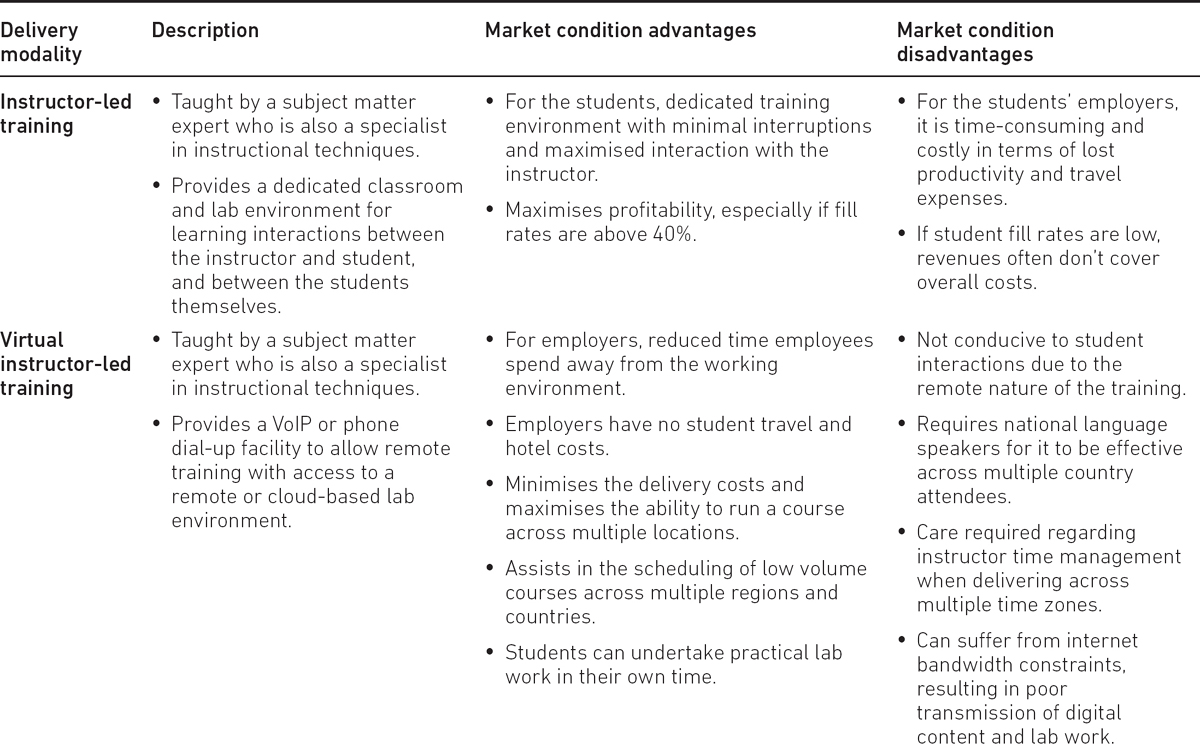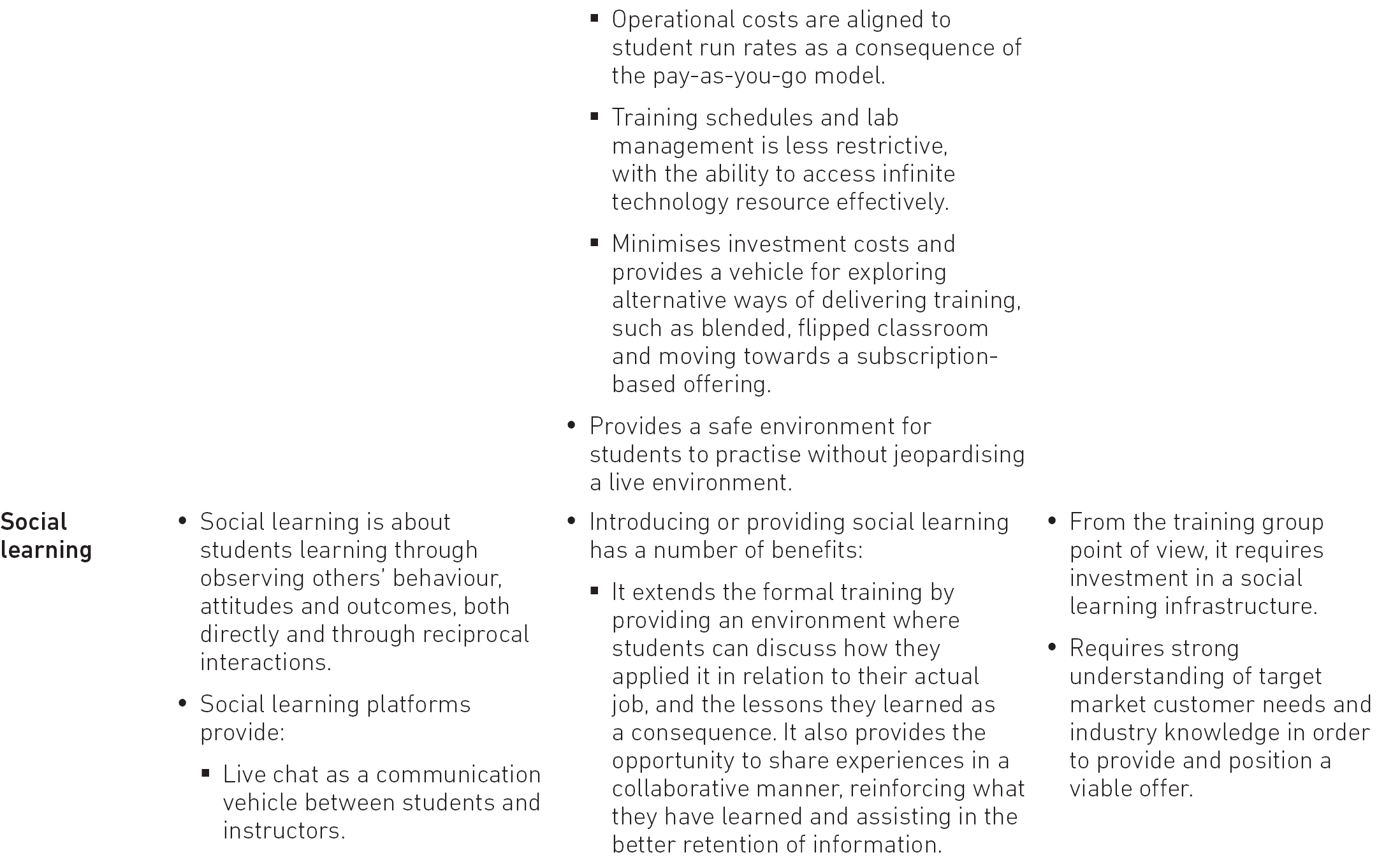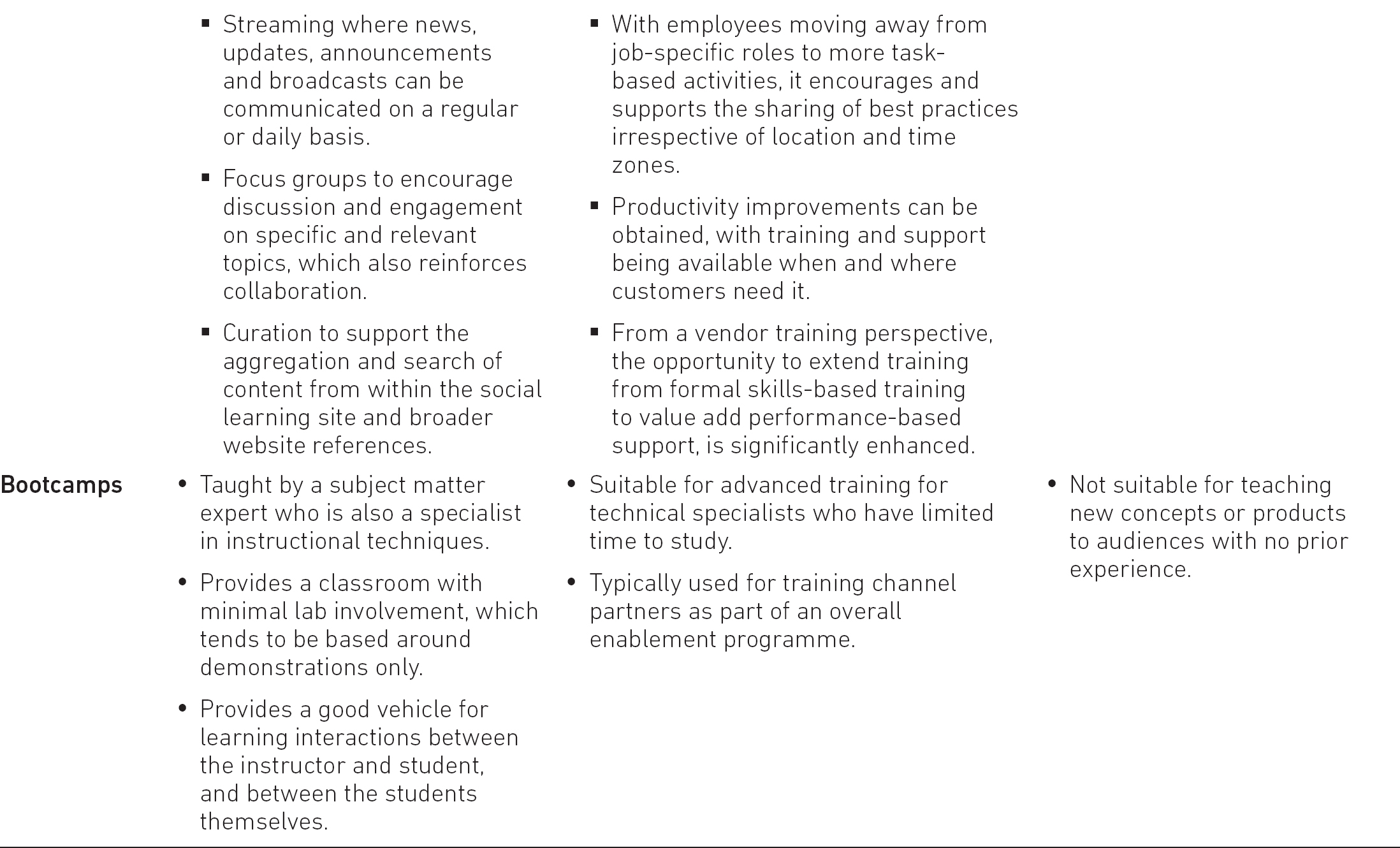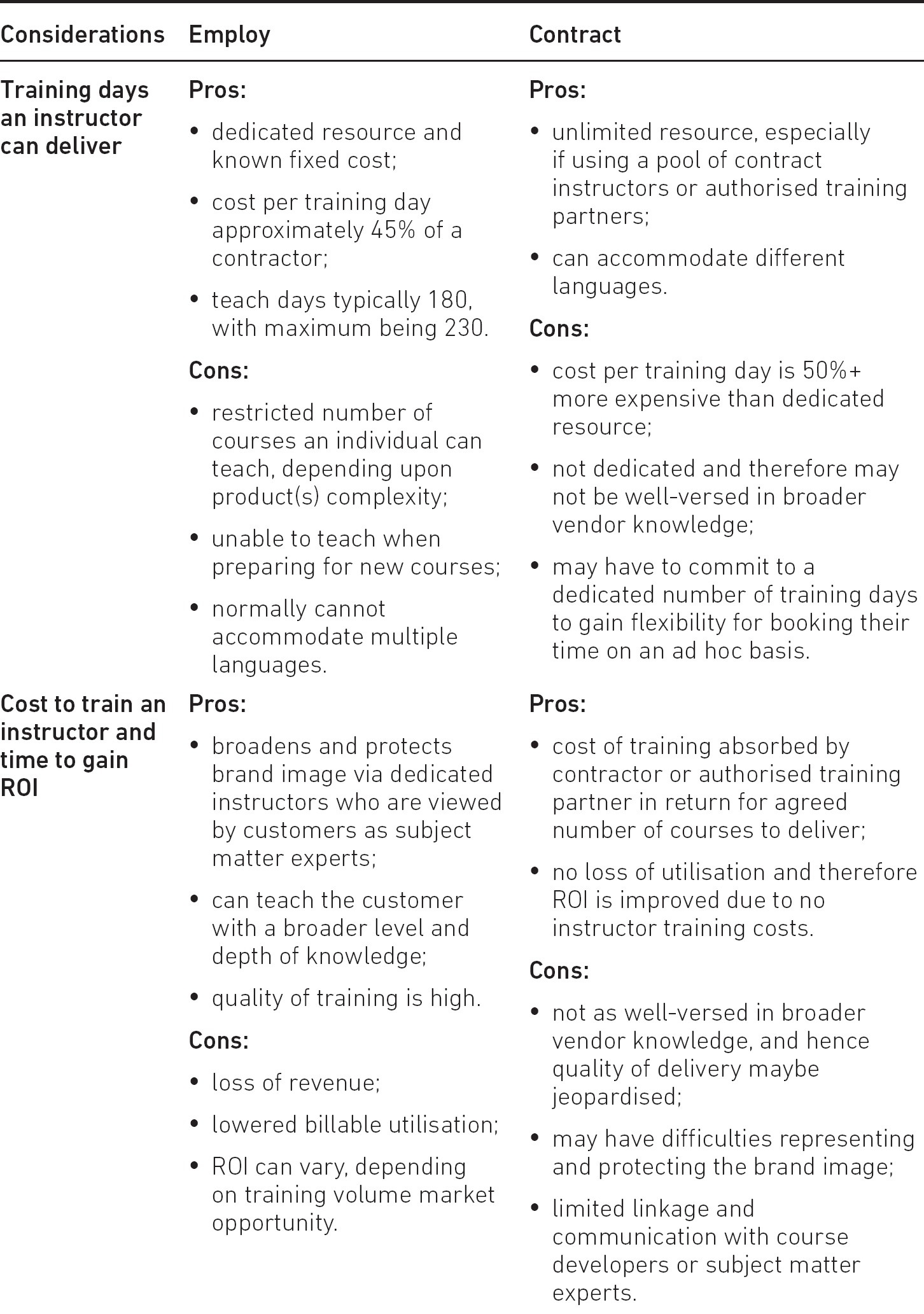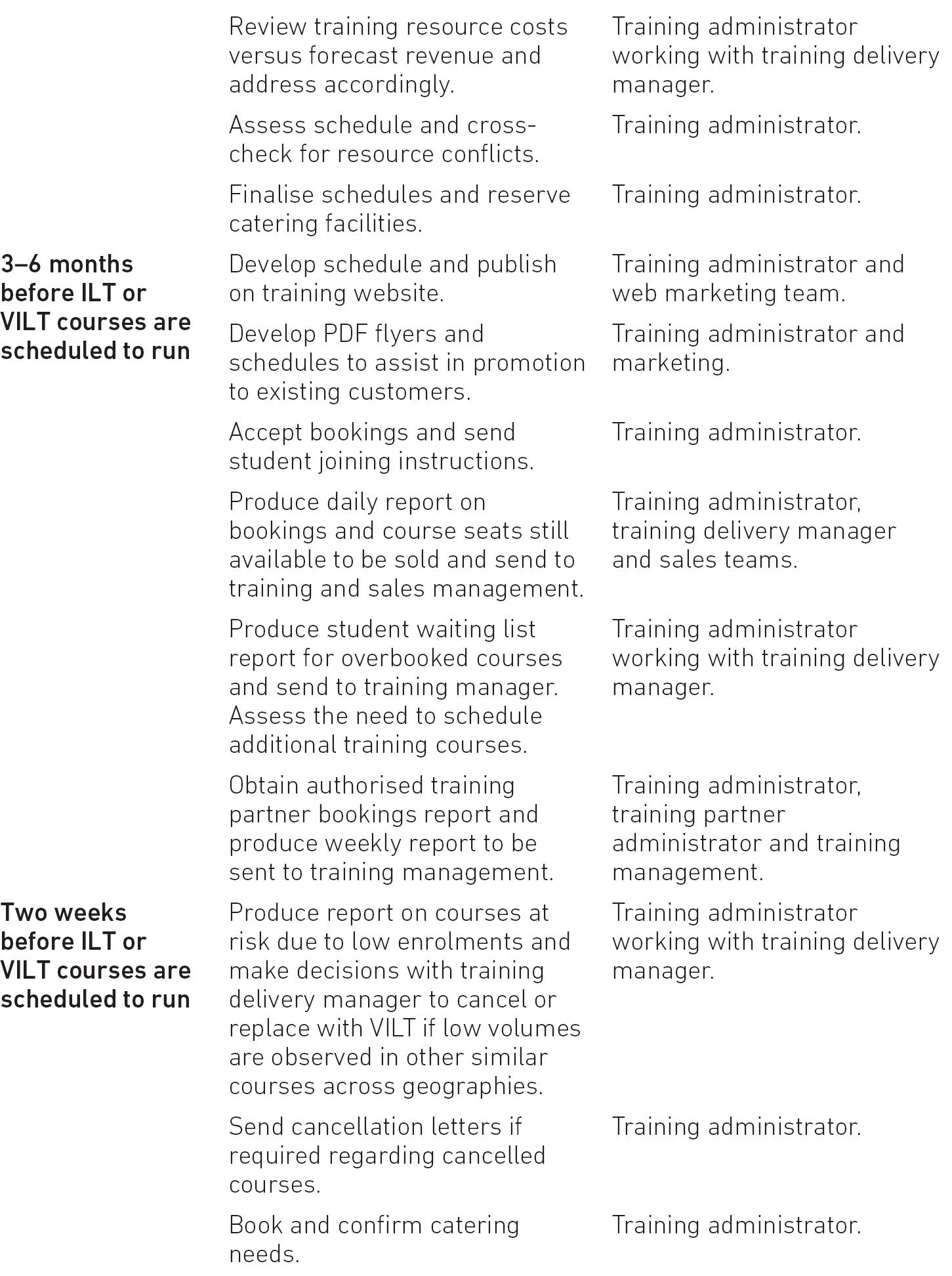Selling to an opportunity is in itself a business challenge. However, it is catastrophic not to have the capability to deliver. This is where understanding and interpreting demand is key, especially in relation to managing the business for both commercial and product success.
This chapter discusses the main tasks associated with scheduling and resourcing training courses together with understanding and interpreting demand, including how to cater for regional variance by way of enhancing or minimising the curriculum on offer. Practical challenges covering scheduling the right modality for the right market need, managing the delivery resource in an efficient manner, managing cost and revenue expectations, and factoring in international needs are then outlined and a scheduling checklist provided for reference and consideration.
UNDERSTANDING AND INTERPRETING DEMAND
As discussed previously, part of a product manager’s role is to decide what marketing strategies should be used to launch a training offering onto the market, with the marketing department assessing who to sell to, what to sell and how to offer it in terms of maximising the training offering penetration.
From a delivery perspective, the scheduling and resource management side of the business needs to be aligned to the opportunity, but also needs to reflect the realities of supporting the anticipated market need. To do this, the team responsible for scheduling and resource management needs to understand the following:
- The nature of the training modality being offered:
- ILT will require instructor resource as well as classrooms, lab equipment (dedicated or cloud-based) and catering.
- VILT will require instructor resource, a conference phone or VoIP and a virtual training lab with 24-hour access for the duration of the course.
- eLearning requires access to a training portal where students download subject matter content via the internet.
- The level of student engagement and interaction being offered outside the standard training offering:
- access to an electronic performance support system (EPSS) (see Chapter 11 for more details) to enhance the learning experience of students;
- social learning support via a dedicated portal to encourage student interaction between themselves and the instructors.
- The availability of resources:
- instructors with relevant skills and knowledge;
- classroom availability;
- training partner availability and the nature of the commercial relationship;
- technical infrastructure in support of VoIP, dedicated and virtual labs, training portals, EPSS and social learning.
- Geographic coverage requirements:
- countries;
- language requirements.
- Commercial needs:
- country pricing and revenue requirements;
- discount policies to cater for internal, customer or partner bookings, including discounts for multiple student orders;
- costing guidelines to allow decisions to be made regarding the engagement of resources that do not impinge on course or training department profitability.
- Target student volumes:
- by training offering;
- by country;
- by student type to ensure the mix of partners, internal employees and customers is balanced according to financial need.
Once these six points have been understood, the team responsible for scheduling can start to assess how best to plan and implement the provision of the training. Typically, they assess resource gaps in relation to revenue and target market goals, and work with the training delivery team to plan how to address any shortfalls.
Once the resource needs have been addressed, scheduling of courses can commence, with the team assessing and analysing the following on a weekly basis:
- Course booking rate, sometimes known as order rate or run rate.
- Cancellation rates regarding students who booked and then cancelled prior to the running of the course.
- Fill rates regarding the level of places sold on a course; for example, a 12-seat training class with nine students booked on it is a fill rate of 75 per cent.
- Standby rates regarding the number of students waiting to book on a course when it is fully booked.
- Rolling forecast of advanced booking rates, which relates to how far ahead courses are booked and to what level. For example, a course may be scheduled to run once every two weeks for six months. If the course was fully booked one month ahead, 50 per cent two months ahead, 20 per cent three months ahead and 10 per cent four months ahead, by monitoring on a weekly basis, a view can be obtained regarding the market demand on a short-, medium- and long-term basis. This allows decisions to be made regarding increasing or decreasing the frequency of courses and provides useful advance information about the need to implement additional sales or marketing activities.
- Cost of sales forecast where specific course offerings can be assessed in terms of costs to run the course versus the revenue generated. This is especially important when external resources are required to run a course, which can affect the profitability on low fill rate courses quite significantly.
The ability to monitor, report and forecast on a regular basis provides an excellent vehicle for making decisions regarding frequency of provision, level of discounts and whether to use internal or contracted resources. It also provides an insight into demand, whereby an ILT course could be substituted with a VILT, which increases profitability and does not require multiple classrooms to be tied up when demand is split across multiple locations.
ENHANCING THE CURRICULUM TO SUIT LOCAL CUSTOMER NEED
There is an old saying, ‘Content is king!’, which is true to a certain extent. However, the level of support and the nature of engagement can also significantly enhance its value.
Most training delivery teams rely on the output from product management and curriculum development teams to provide a curriculum that supports their customers’ needs and provides a means to generate revenue in line with corporate and business unit requirements.
The reality can be different at the local level, with regional and geographic differences forcing a different mindset. What works at headquarters level does not always work locally because of differing market conditions and product sales opportunities. In some industries the standard training offering may not suffice. The financial sector, for example, may have differing training needs from that of the manufacturing sector, due to legal statute requirements.
Therefore, local training delivery teams may need to consider enhancing the existing corporate curriculum to ensure they hit their specific goals, or overachieve based on their market opportunity, or satisfy specific needs in their region of operation.
The technical training curriculum can be enhanced by local delivery teams in several ways:
- Offer advanced training on a workshop demand basis to minimise the need for content to be developed as a formal course and to be delivered by subject matter experts.
- Offer industry-specific content for private training opportunities.
- Offer post-training support via a local training portal with asynchronous access to an instructor.
- Engage authorised training partners to provide access to content they have developed.
- Work with strategic product partners and offer their complementary courses.
- Offer skill gap analysis to customers requiring private training.
- Offer boot camps and re-skilling sessions.
MINIMISING THE CURRICULUM OFFERED TO SUIT LOCAL CUSTOMER NEED
Delivery teams, especially those covering complex and diverse geographical and language-based regions, may elect to schedule a minimum curriculum based on market demand, ability to resource and expected returns.
Companies with headquarters in the USA often produce English-only material and require the geographic-based subsidiaries to fund translations. From the European and Asia Pacific perspective, cost of translation may be far outweighed by the sheer number of languages to be translated in relation to the market opportunity. In these instances, the delivery teams will schedule a minimum curriculum to ensure basic training only is provided.
SCHEDULING THE RIGHT MODALITY TO THE RIGHT MARKET CONDITIONS
Training has to reflect the ongoing changes taking place culturally, economically, socially and technologically in the way it is delivered.
Global economic growth is accelerating and the work ethic is becoming more centred around commercial success and improved productivity. This places increased demands on employers to minimise training expense and the time their employees spend away from the office.
For training providers, alternative modals need to be considered outside the traditional ILT, as does the need to balance training provision against the pressures of satisfying variable demand in a commercially viable manner. Table 8.1 provides an overview of alternative approaches that can be adopted for different market conditions and commercial needs.
SIZING, SCALING AND MANAGING THE DELIVERY RESOURCE
One of the many challenges facing a training delivery manager is how to assess the business in terms of expected training volume and number of staff required to support it, and how to manage the resource pool so that variations in demand are handled in an effective, productive and cost-efficient manner.
Table 8.1 Scheduling the right modality for the right market conditions
Sizing a training business requires an understanding of what the training product management team views as the market opportunity, and how and where the business development managers and sales teams intend to position and sell the training.
The product management team can provide an overview of the following:
- training offerings;
- training modalities;
- market opportunity by industry sector and geographic region;
- pricing by geography.
Whereas business development managers can provide the following:
- target revenue or volume by offering and modality;
- target revenue or volume by geography;
- budgetary guidance based on costs and expected profitability, depending on the business model in force at the time;
- route to market contact points and expected revenue requirements.
The sales manager, whose main focus is on guiding the sales team to sell to the target market opportunity, can provide the following key information:
- sales bookings forecast by offering, modality, location and time to convert from prospecting to closure;
- the level and size of discounts granted, which need to be monitored to ensure overall margins are not compromised.
With this level of information, the training delivery manager and administration team can construct a meaningful schedule of training offerings, based on the business development manager’s view of the market opportunity balanced against the realities of the sales team’s activities.
The first stage is sizing the opportunity in terms of how many courses to offer and where they should be located. The next stage is aligning appropriate delivery resource, taking into account any language requirements and the frequency of the offering.
If the frequency is low – for example, offering one or two courses instead of a normal expectation of four or five – consideration should be given to establishing relationships with either authorised training partners or independent instructors. This is also a typical consideration when factoring in language variance, when the permanent instructor pool may be limited in its language proficiency.
Establishing access to a pool of temporary resources allows the training delivery team to scale without commitment to expanding the permanent delivery resources. One of the major challenges is sizing the actual number of permanent delivery staff required to support the offerings and ensuring that they generate the right level of financial return to justify the investment in them. One approach that can be considered is:
- Assess if the number of courses an instructor can support, in line with market opportunity and assumed sales success, achieves the following:
- agreed annual instructor utilisation (typically 180 teaching days, depending on annual leave and public holiday allocations);
- desired class fill rate; note that class size is a function of course complexity, so will vary from one course to another;
- average revenue per class after discounts, which provides a gross margin (after instructor, classroom, lab, course materials and refreshment costs are removed) of 60–70 per cent.
On a class size of 12, for instance, the business model should be based on a 70 per cent fill rate (typically eight to nine paying students).
- Assess if the level of investment in instructor development and infrastructure resource will deliver the required return on investment over an acceptable period of time. For example, if the main market interest is spread across multiple countries, and hence languages, then the use of contractor resource is more financially viable. On a course by course basis, it provides a lower gross margin but does not adversely affect the fixed cost margin contribution where permanent instructors are unable to deliver the revenue.
- Assess any seasonal impact; for example, in Europe the summer season can have a major influence on revenue and margins due to customer vacations. Therefore, when sizing the number of permanent instructors and classrooms required, consideration should be given to factoring this into the decision process. This is where the use of authorised training providers and contractors can be an effective solution, allowing the training to be supported on an on-demand basis.
When looking to scale a training business in terms of supporting training volume fluctuation, be it expansion or contraction, the following should be considered:
- Assess the benefits of increasing the permanent resources versus overall exposure to the business should the forecasted growth decline.
- Develop an authorised training partner network in regions where language or cultural issues can be best supported by local expertise, or where the training partner network has an established market presence and penetration.
- Use training contractors to accommodate growth, or provide coverage for permanent instructors who may be undergoing re-training in preparation for new product and training offering releases.
- Develop VILT offerings that allow broader coverage and reach without requiring training rooms to be allocated.
Managing the training resource overall requires a good understanding of the capability and availability of the fixed and temporary resource pools. It also requires constant assessment of the way in which the market opportunity is developing.
Market and sales analysis is an important function that all training delivery managers need to be competent in. It forms the basis by which all decisions around sizing and scaling the business are made. Understanding the sales forecast and being personally accountable is fundamental to training delivery success. Whether the sales bookings are below, on target or above, it is important to know why and be able to challenge, encourage and motivate interaction and engagement with sales facing staff. In other words, take control: no sale equates to no delivery!
Training delivery can also act as a controlling agent with views on what the market needs, what the market is buying and how it provides signals on changes that may impact the success of training moving forward.
RESOURCING EFFICIENCY (CONTRACT OR EMPLOY)
In the previous section, sizing and scalability were two key factors a training delivery manager needs to consider in order to decide how best to resource the delivery team’s headcount. Of course, the underlying factor is cost. For a training organisation based on profit, cost control is as important as it is for a cost centre-based group.
With one of the main costs being headcount, it is important to ensure instructor efficiency and effectiveness is achieved. Making decisions on headcount comes down to:
- How many training days can an instructor deliver without affecting the quality of service provided?
- How much does it cost to train an instructor on a new training offering before they become productive and what is the ROI?
- How versatile are the instructors? Can they deliver different courses, and can they teach in multiple languages?
- What is the training demand and requirement to support the headcount?
- For profit-centred training groups, are the finances measured and reported annually or quarterly?
- What alternatives are there to increasing the training volume and level of profitability without loading the organisation with increased headcount?
One of the many considerations a training product manager and training manager need to look at is that of employing or contracting instructors to balance expected customer demand versus cost of providing the training and maximising the profit contribution. Table 8.2 highlights the pros and cons of this conundrum.
Table 8.2 Employ versus contract considerations
When engaging contract instructors, it is important to ensure that there is a legally binding contract in place to clearly define the business relationship, delivery expectations, expected modes of behaviour and required metrics, including predefined quality expectations. It also protects the aspects of customer and training group confidentiality.
The checklist in Table 8.3 highlights some of the more common tasks a training coordinator or training administrator is involved with regarding the scheduling of courses in a commercial training environment. Note that some elements of the checklist may be undertaken by multiple administrators as some may focus on scheduling resources only and others deal with the booking and billing side, depending on the business volumes they are supporting.
Table 8.3 Scheduling checklist
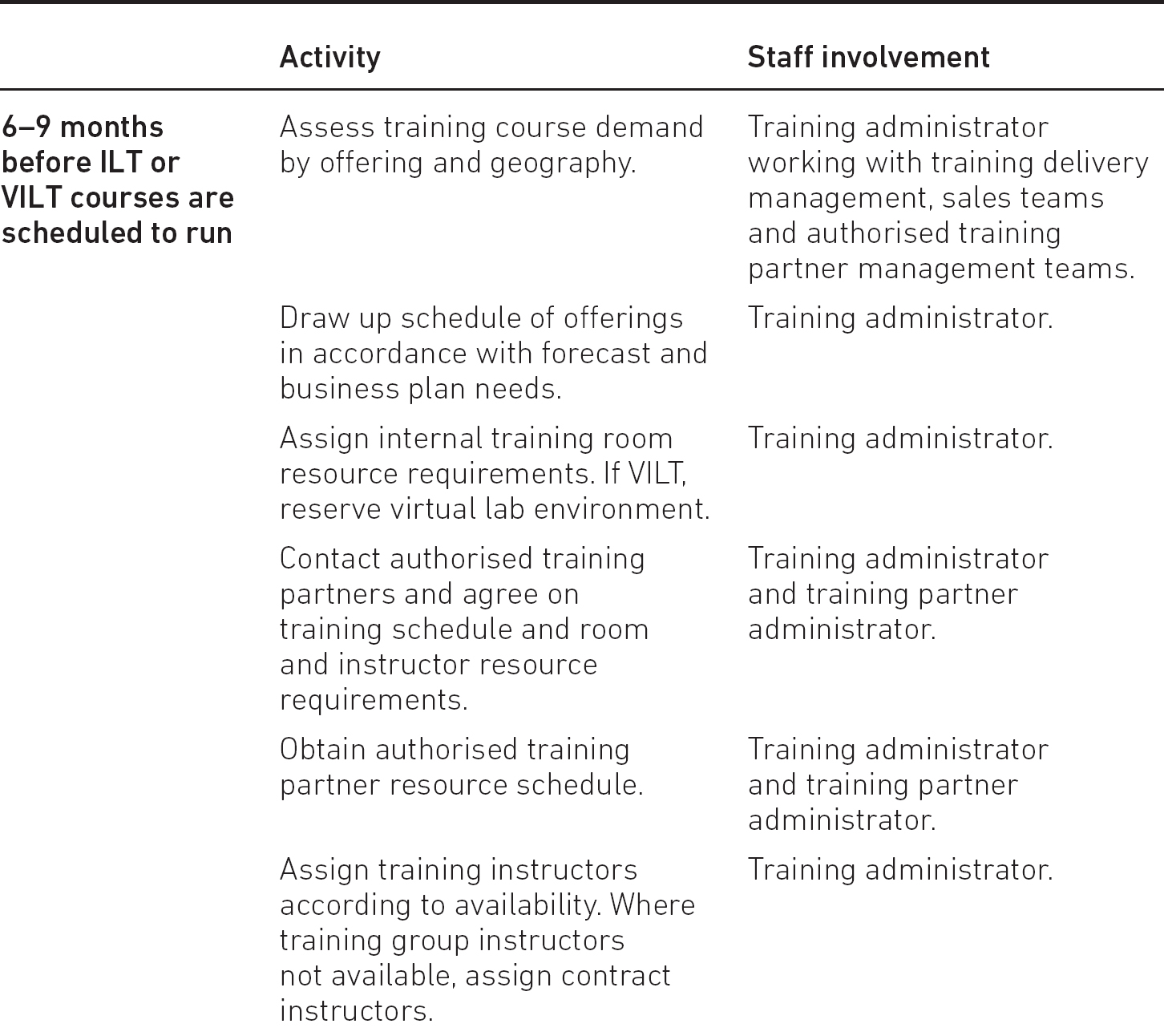
INTERNATIONAL AND LANGUAGE CONSIDERATIONS
Understanding cultural differences is as important, if not more so, as translating or delivering in a country’s local language. Get it wrong and the market opportunity and brand damage can be costly, especially when operating in a competitive product environment.
As training is a service, it is important that time is spent becoming culturally aware because of the significant communication element involved in training, be it instructor-led or eLearning. Therefore, the first priority of a training delivery manager supporting a cross-cultural region is to ensure that the teaching is adapted to suit the target community.
English is the international business language and one that is used extensively in the world of information technology, so in many countries it is permissible to provide English written course content that is delivered in English or in the local language. If a course is being delivered in English to a foreign audience, consideration needs to be given to the pace of the course and time for frequent local language discussions to occur between students.
Optimally, courses should be translated and presented in the local language. Several factors need to be considered in order to make decisions regarding how to proceed:
- Is it strategically important for the company to have service provision in the local language?
- If it is, is general funding available that minimises any impact on the training department’s fiscal responsibilities? If not, there will be a need to locate and negotiate with internal sponsors for funding, where they depend on the service being available.
- Does the revenue goal depend upon offering training in various countries?
- If yes, consideration needs to be given to the effect on margin contribution regarding the following alternative strategies:
- Content is provided in English and the instructor teaches in the local language. The cost of hiring an appropriate instructor needs to be balanced against ability to generate required revenue and margin contribution over the lifecycle of the offering.
- Content is translated and taught in the local language, which results in both revenue and agreed margin attainment.
- Training is undertaken by an authorised training partner, who translates and delivers in the local language. The partner could acquire the English content under licence and translate at their own expense, with revenue contribution being based on an agreed percentage of sales.
- If yes, consideration needs to be given to the effect on margin contribution regarding the following alternative strategies:
Websites, marketing and promotional material also need to be translated and factored into the overall costs of development and operational expense.
Finally, ensure that all training schedules and booking instructions clearly state when a course is available:
- in English only;
- delivered by a local language speaker using English-only content;
- delivered using translated content by a local language instructor.
MANAGING COST AND REVENUE EXPECTATIONS
As discussed previously, there are many elements to how a training business is sized in terms of its training volume, staffing levels and cost allocations. Once this has been understood and defined, the next stage is how to manage the resultant revenue and cost expectations within the agreed business plan requirements.
Whether the reporting cycle is monthly, quarterly, annually or a combination will determine the level of flexibility a training manager has regarding how best to report and manage the inevitable changes that occur during the various reporting periods.
Being held to a monthly target with no ability to correct within a quarter is difficult, and would probably result in the development of a cautious monthly plan. Alternatively, an annual target can drive a more ambitious approach with the option to deliver strong results towards the latter part of the year, sometimes referred to as a back-loaded plan.
Neither is particularly favourable if they are not based on reality in terms of market need and opportunity.
Assuming the plans put forward and agreed to are based on actual market need and potential, then the importance of metrics and trend analysis come into play. Order and cancellation rates can provide an insight into short- to medium-term issues or opportunities, depending upon whether they are rising or falling, as can the delay between order to actual training delivery, all of which have an effect not just on revenue but on costs too. If revenue demand is growing in an unexpected manner, decisions will need to be made as to whether to schedule additional courses, with the resultant effect on costs, or move the demand to another month or quarter.
Being able to explain with robust metrics and highlight trend changes assists the training manager not only to manage the revenue and cost aspects but also to set the right level of expectation as the plan evolves over its reporting period.
Table 8.4 provides some examples of how to manage cost and revenue expectations for several situations that might arise over a reporting period.
Training delivery managers need to assess their business in terms of expected training volume, number of staff required to support it and how to manage the resource pool so that variations in demand are handled in an effective, productive and cost-efficient manner.
Understanding and interpreting demand is an important activity, allowing for effective planning to be undertaken. It covers the training offerings, the environment to support them, allocation of resources and financial management in terms of revenue, cost control and profits.
Table 8.4 Managing cost and revenue expectations
The ability to monitor, report and forecast enables decisions to be made regarding the frequency of offering, level of discounts, enhancing or minimising the curriculum, and whether to use internal or contracted resources.
By optimising resource efficiency, decisions can be made regarding how to size and scale for growth and manage cost and revenue expectations in a controlled manner.

